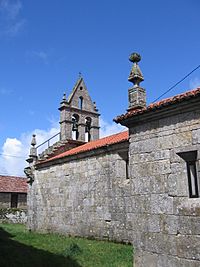Santiago de Rubiás facts for kids
Santiago de Rubiás is a small village in Spain, located in the region of Galicia. It's part of a larger area called Calvos de Randín in the Ourense province. In 2007, about 65 people lived there. Santiago de Rubiás is special because it used to be the capital of a unique, almost independent place called Couto Misto until 1868.
Contents
Santiago de Rubiás: A Village with a Secret Past
Santiago de Rubiás might seem like a quiet village today, but it has an amazing history! For many years, it was at the heart of a very unusual territory that acted like its own small country. This makes Santiago de Rubiás a fascinating place to learn about.
Where is Santiago de Rubiás?
Santiago de Rubiás is found in the northwest part of Spain, in a region known as Galicia. This area is famous for its green landscapes, rainy weather, and beautiful coastlines. The village is nestled inland, close to the border with Portugal. Being near the border played a big role in its unique history.
The Unique Story of Couto Misto
For centuries, Santiago de Rubiás, along with two other nearby villages called Meaus and Rubiás, formed a special territory known as Couto Misto. This area was not fully controlled by either Spain or Portugal. It was like a tiny, independent land right between two big countries!
What was Couto Misto?
Couto Misto was a small piece of land that had its own rules and freedoms. It wasn't officially a country, but it acted like one in many ways. The people living there had special rights that people in Spain or Portugal didn't have. For example, they didn't have to join the army of either country, and they could grow tobacco, which was illegal in Spain. They also had their own way of choosing leaders.
How Did Couto Misto Work?
The people of Couto Misto managed their own affairs. They had a special book called the "Book of Privileges" that listed all their unique rights. They chose their own leaders, called "men of good standing," from each of the three villages. These leaders would meet in Santiago de Rubiás, which was considered the capital, to make decisions for the community. They even had their own customs and traditions that were different from their neighbors.
The End of Couto Misto
The special status of Couto Misto lasted for a very long time, but it eventually came to an end. In 1868, Spain and Portugal signed a treaty that officially divided the territory. Couto Misto was split, and Santiago de Rubiás became fully part of Spain. This marked the end of its long history as an almost independent land.
Santiago de Rubiás Today
Today, Santiago de Rubiás is a peaceful village, much like many others in rural Spain. While its unique past as the capital of Couto Misto is now history, it remains an important part of the village's identity. Visitors can still see the old church, the Church of Santiago, which has stood for centuries and witnessed many of the events of Couto Misto's past.
See also
 In Spanish: Santiago (Calvos de Randín) para niños
In Spanish: Santiago (Calvos de Randín) para niños


